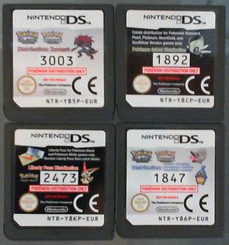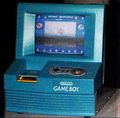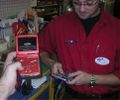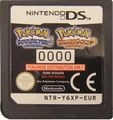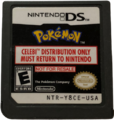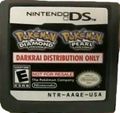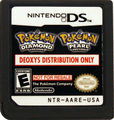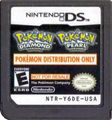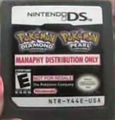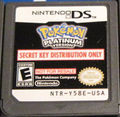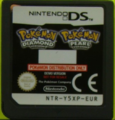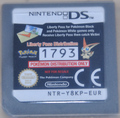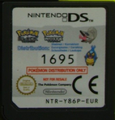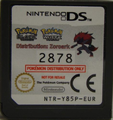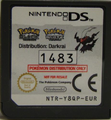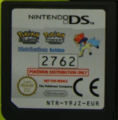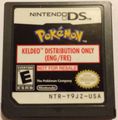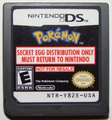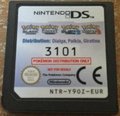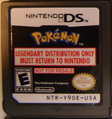Distribution device: Difference between revisions
Blueapple128 (talk | contribs) |
|||
| Line 34: | Line 34: | ||
Distribution cartridges are given to stores for event distributions, and are not sold commercially. Starting in [[Generation IV]], they only contain information for the event Pokémon, and have no actual game data or save possibilities. These cartridges use [[DS Wireless Communications]] to distribute events starting in Generation IV. At the end of an event, they are intended to be sent to Nintendo's Waste Management facility in Redmond, Washington, where they are presumably destroyed. However, sometimes, distribution cartridges are leaked or sold to the public. | Distribution cartridges are given to stores for event distributions, and are not sold commercially. Starting in [[Generation IV]], they only contain information for the event Pokémon, and have no actual game data or save possibilities. These cartridges use [[DS Wireless Communications]] to distribute events starting in Generation IV. At the end of an event, they are intended to be sent to Nintendo's Waste Management facility in Redmond, Washington, where they are presumably destroyed. However, sometimes, distribution cartridges are leaked or sold to the public. | ||
No distribution cartridges are known to exist for event distributions for the post-Generation V games. | No distribution cartridges are known to exist for event distributions for the post-Generation V games, presumably due to the advent of full digital games. | ||
===Generation III=== | ===Generation III=== | ||
Revision as of 08:56, 11 July 2022

|
This article is incomplete. Please feel free to edit this article to add missing information and complete it. Reason: Additional distribution methods |
Distribution devices are special devices that are used to distribute Pokémon events.
Distribution devices include machines, distribution cartridges, Pokémon Colosseum Bonus Discs, European and Australian versions of Pokémon Channel, the GameCube Interactive Multi-Game Demo Disc Version 14 and 16, Game Link Cables, Game Boy Advance Wireless Adapters, and infrared. However, other methods of distributing events includes Wi-Fi and mailing in a game cartridge.
Pokémon Machines
Special Machine
The Special Machine (Japanese: 特製マシン) was used to distribute event Pokémon in Generation I starting with the Nintendo Space World '97 Mew distribution. It was mainly used to distribute Mew but also other events like Surfing Pikachu. An updated version was used starting with the Nintendo Space World 2000 Celebi for all Celebi events during Generation II. Pokémon game cartridges containing event Pokémon downloaded from machines were sometimes used as distribution cartridges, the event Pokémon were exchanged via Game Link Cable.
Generation I
Special machine for distributing Nintendo Space World '99 Mew
Generation II
Special machine for distributing Pokémon Fun Fest Celebi
Pokémon Distribution Machine
The Pokémon Distribution Machine (Japanese: ポケモン配布マシン) also known as Pokémon Vending Machine was used to distribute campaign distributions in Generation II at Pokémon Centers and debuted with the opening of the Pokémon Center New York for the distribution of the Gotta catch 'em all! campaigns. It was also used in Japanese Pokémon Centers to distribute the Mystery Egg campaigns. An updated version of the machine's software for Generation III was made in June, 2003 and used for the distribution of Wishing Star Jirachi at the 18th World Hobby Fair and Pokémon Festa 2003 in Japan. In August, 2003 the machines from the Pokémon Center New York were updated for the distribution of the Gotta Catch 'Em All campaigns in Generation III. The Pokémon Center New York machines were promoted as "Gotta Catch 'Em All Stations" and later succeeded by a different hardware setup promoted as the new Gotta Catch 'Em All Station which was used for the wireless Mystery Gift distribution of the Wish Eggs campaign. The distribution machine was connected to a developer Gamecube and stored configurations, logs, and other information on a memory card. While shiny Pokémon could be configured, this was never used in Generation III. The devices distribution could was used as the Trainer ID starting with 1. If more than 65535 Pokémon were distributed without restarting or powering off the device, then the ID would overflow to 0.
Generation II
New York Pokémon Center's "Gotta Catch 'Em All Station"
Distribution Cartridges
Game Link Cables were used to distribute many events until the start of Generation IV. Starting in Generation V, infrared was used to distribute certain events in Japan and South Korea.
Distribution cartridges are given to stores for event distributions, and are not sold commercially. Starting in Generation IV, they only contain information for the event Pokémon, and have no actual game data or save possibilities. These cartridges use DS Wireless Communications to distribute events starting in Generation IV. At the end of an event, they are intended to be sent to Nintendo's Waste Management facility in Redmond, Washington, where they are presumably destroyed. However, sometimes, distribution cartridges are leaked or sold to the public.
No distribution cartridges are known to exist for event distributions for the post-Generation V games, presumably due to the advent of full digital games.
Generation III
Waiting for a distribution in Generation III
Distribution system used for the Top 10 Pokémon
Mystery Mew link trade distribution
Distribution system used in Generation III
Generation IV
Waiting for a distribution in Generation IV
Active distribution in Generation IV
Expired distribution in Generation IV
European Michina Arceus distribution DS card
Toys "R" Us Arceus distribution DS card
European Winter 2011 Celebi distribution DS card
Americas Winter 2011 Celebi distribution DS card
Toys "R" Us Darkrai distribution DS card
GameStop Deoxys distribution DS card
Toys "R" Us Dragonite distribution DS card
GameStop Pikachu-colored Pichu and GameStop Jirachi distribution DS card
GameStop legendary beasts (and undistributed Celebi) distribution DS card
Toys "R" Us Manaphy distribution DS card
Toys "R" Us Ash's Pikachu distribution DS card
US Secret Key distribution DS card
Movie 11 Shaymin distribution DS card
10th Movie Deoxys distribution Slot 2 cartridge
Generation V
Waiting for a distribution in Generation V
Active distribution in Generation V
Expired distribution in Generation V
European Liberty Ticket distribution cartridge
European Summer 2011 Karrablast and Summer 2011 Shelmet distribution cartridge
European Summer 2011 Zoroark distribution cartridge
US Zoroark Month Zoroark distribution cartridge
European Winter 2011 Darkrai distribution cartridge
European Summer 2012 Keldeo distribution cartridge
US Summer 2012 Keldeo distribution cartridge
European Spring 2013 Meloetta distribution cartridge
US Spring 2013 Meloetta distribution cartridge
US Secret Eggs distribution cartridge
European International Summer 2013 Shiny creation trio distribution cartridge
United States Summer 2013 Shiny creation trio distribution cartridge
See also

|
This game-related article is part of Project Games, a Bulbapedia project that aims to write comprehensive articles on the Pokémon games. |
